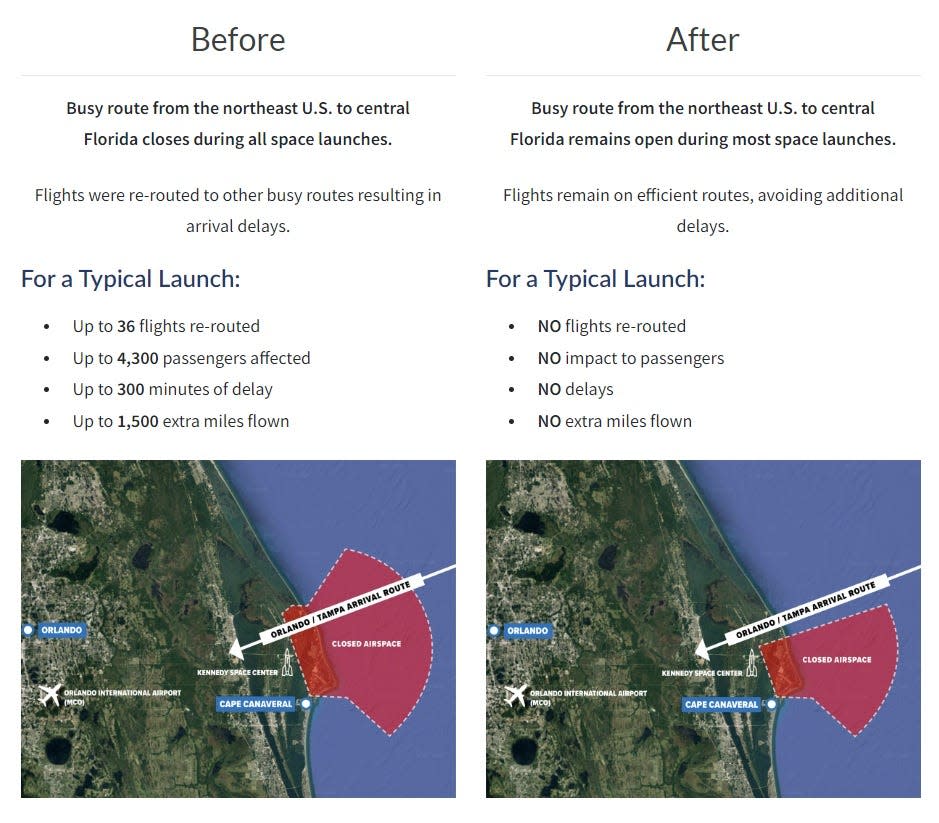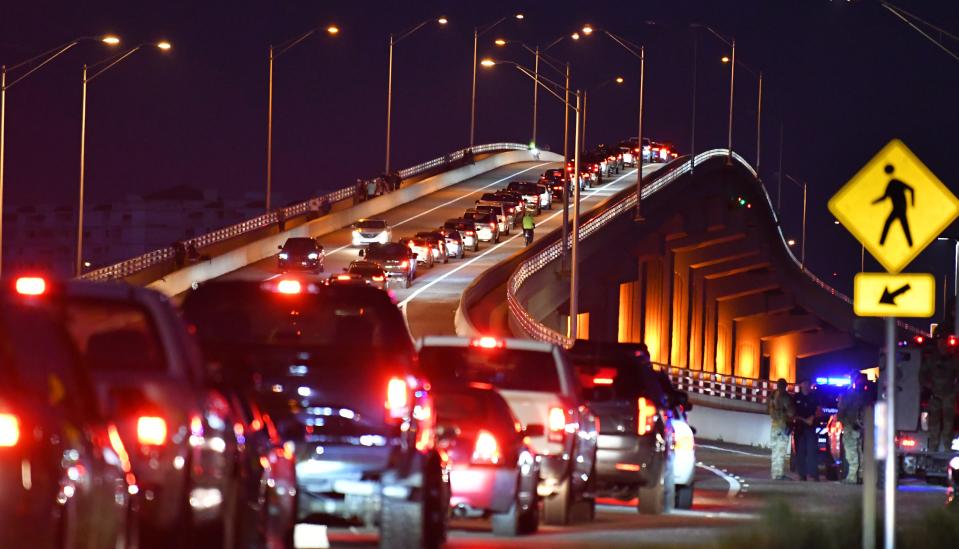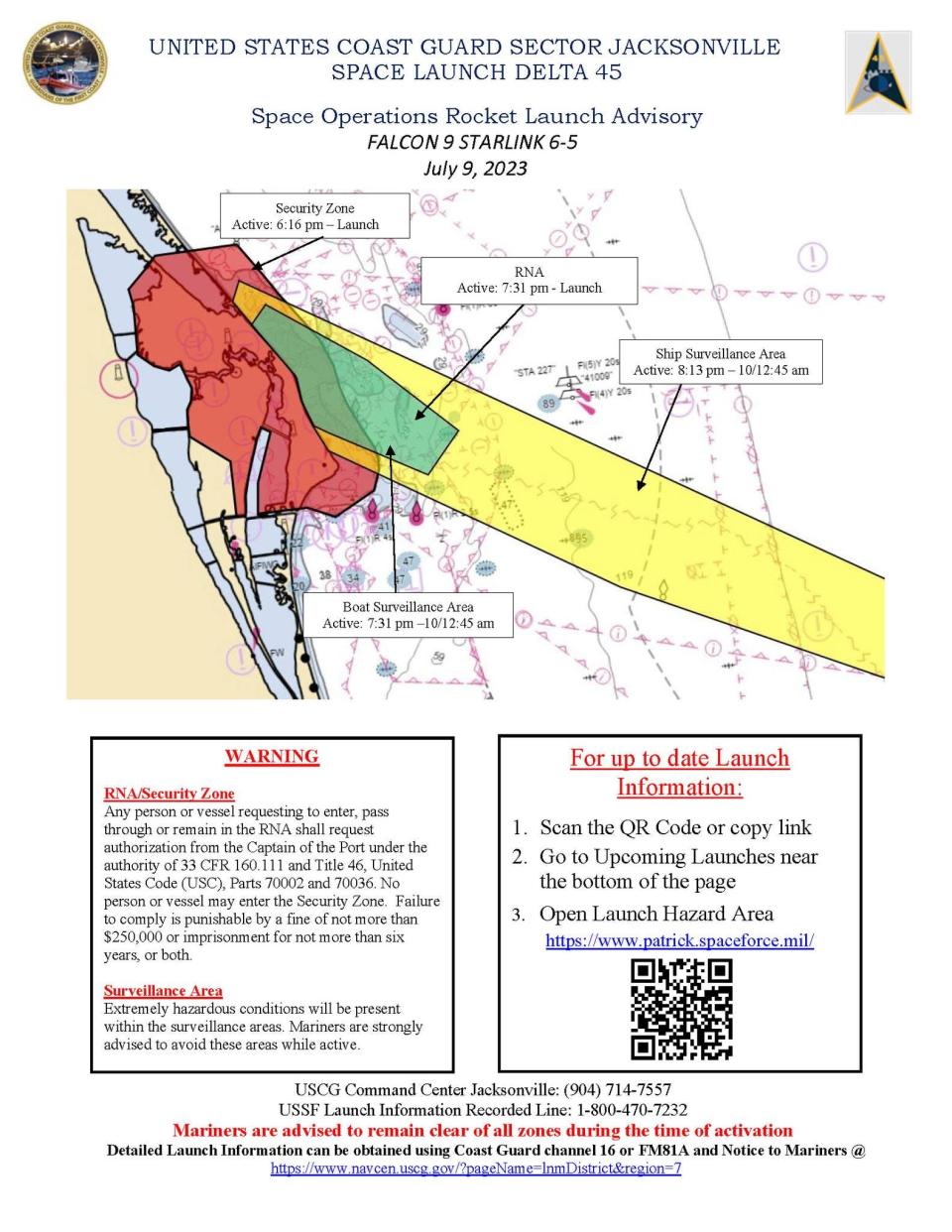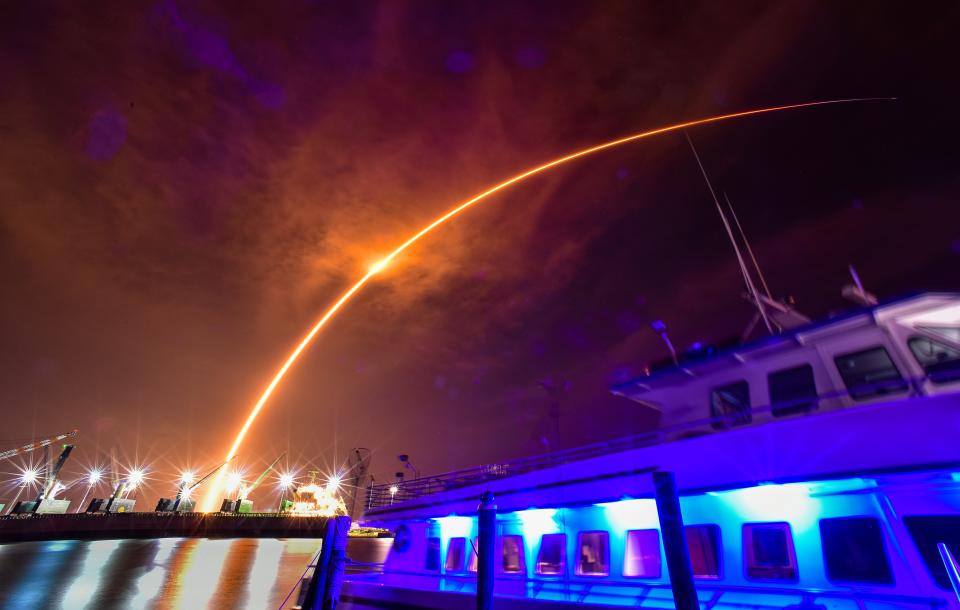Increase in launches creates impacts for aviation, emergency management, public safety
Airplane flight rules. Boat restrictions. Emergency preparedness. Traffic assistance.
The big boost in launches on the Space Coast isn't just bringing more tourists to Brevard, it also has a ripple effect on other industries as they work to accommodate — or, in some cases, capitalize — on the unprecedented pace.
Airlines, cruise ships, emergency operations officials and police have had to adjust as the skies above the Space Coast get busier.
The Space Force, which runs the Eastern Range, has collaborated with partner organizations like the Federal Aviation Administration and commercial spaceflight companies to shrink potential hazard zones, making it easier on planes and boats.
Here are some of the ways the uptick in launches is impacting other areas of the Space Coast.
Rocket launch impacts on the airline industry
Shem Malmquist, an instructor at Florida Institute of Technology's College of Aeronautics, said launches can result in route changes for commercial airline flights.
"In a nutshell, you have to close off a region of airspace off the coast," said Malmquist, who also is a Boeing 777 captain, flying primarily on international routes.
Airspace, for example, could be restricted 30 to 50 miles off the coast, potentially forcing airlines to modify their preferred routes. Those delays can affect flights to and from the Northeast, as well as trans-Atlantic routes.
That, he said, has the potential to create additional bottlenecks for airlines, especially if there already are storms over Florida restricting airspace, potentially adding 30 minutes to a scheduled flight time.
Future launch changes: NASA shuffles astronaut missions, Boeing's Starliner to remain grounded even longer
"It's almost like another obstacle up there," Malmquist said.
One way the Federal Aviation Administration helped alleviate this pain was with the recent implementation of modified, restricted no-fly zones, making them smaller for most SpaceX Falcon 9 launches.

"Sections of airspace to the north that had been traditionally closed for all launches can now remain open during most launches," the agency said in a release in April. "Based on risk analyses conducted for every launch and working with the U.S. Space Force and space launch operators, the FAA determined the existing airspace restrictions for most Florida launches were too large and could be safely reduced."
This change mainly impacts commercial airline flights that travel northeast of Cape Canaveral Space Force Station and Kennedy Space Center. According to the FAA, the change should help hundreds of passengers experience reduced flight delays.
According to the FAA, from April to mid-June, zero airline flights were required to be rerouted during 10 of the 12 launches that featured the reduced no-fly zone.
Brevard Emergency Operations Center cuts back staffing
Brevard County's Emergency Operations Center in Rockledge is among the most activated facilities of its kind in the country, largely because of the relentless launch cadence schedule.
In 2022, the EOC had 76 total activations, of which 73 were launch-related, including some that resulted in scrubs. The other three were for hurricane or tropical storm activity, with a total of 15 days of storm-related activations.
As of Friday, there were 71 total activations at the EOC this year, including 68 for rocket launches (57 that launched and 11 that scrubbed). The other three activations were weather-related, which generally require more staffing than a launch.

In explaining the launch-related activations, Brevard County Director of Communications Don Walker said: "We activate so we’re in a position to keep the public informed, in case there’s an anomaly and in case there is any type of safety precautions or safety steps that need to be taken as a result."
With the increased frequency of launches, the county in April modified its activation plan, in part to reduce staffing requirements, particularly for less-risky launches that do not have a toxic dispersion risk.
"The frequency of space launches has significantly increased in recent years, and is showing no signs of slowing down," Emergency Operations Center officials said in a memo announcing the changes. "This fact prompted us to reexamine our launch posture/approach."
Jill Biden on Space Coast: First lady Jill Biden tours Space Force bases, supports military spouses on Brevard visit
There now are four classifications of launches, down from the previous six, with the lowest-staffed launches, classified as "non-toxic." The modification of the categories helped reduce the required staffing for most launches. Non-toxic missions are now staffed at the EOC only by the Emergency Management Department's launch coordinator and a public information officer.
Walker said the lowest staffing level for a launch is two for a low-risk launch, and the highest is 25 to 30 for a high-risk radiological launch.
"Emergency Management looks at it by hazard and threat to the public," Walker said. "We work with the Cape and Range Support, which provides us that information. We look at what might affect the general public on land."
Walker said risk factors are primarily toxic fuel and debris, in case of an anomaly.
A high-visibility launch would be one that would bring in a lot of people and traffic that would tie up roadways and pose issues for emergency responders or emergency vehicles trying to get to people in an emergency, Walker said.
An example of a low-risk launch would be a Falcon 9 Starlink mission, such as one that occurred Oct. 17.
The last high-visibility launch was the Falcon 9 NASA Crew-7 on Aug. 26, 2023. The last high-risk and high-visibility launch was Artemis 1 on Nov. 16, 2022.
Walker said a high-visibility launch might occur an average of three to four times a year, and a radiological launch might occur an average of once a year.
For the radiological launches, there are 18 categories of launch support deployed, ranging from firefighting to health/medical, which includes agencies like the National Weather Service and the Florida Department of Transportation.
"We put out messaging all the time, which is a resource to alert the public of what’s going on and when there have been issues in the past," Walker said. "We work closely with other agencies during various launch events on traffic control, public safety, and emergency response," including working with first responders to facilitate access to patients during launches where there is heavy traffic and large crowds, particularly for crewed launches.
Walker said county staff assigned to Emergency Operations Center duty for launches receives "flex time," rather than overtime. That means, for example, if they work for four hours during a launch outside their normal work hours, they can take four hours off at another time during the week.
County, municipal public safety agencies react
Traffic tie-ups ― especially on the days of crewed or other high-profile launches ― are the main issue public safety agencies deal with.
"Other than an increase in vehicular traffic in the area during the launch window, the Sheriff’s Office has not experienced any significant impact to our operations," said Tod Goodyear, public information officer for the Brevard County Sheriff's Office.
Brevard County Fire Rescue Chief Patrick Voltaire said, for most launches, his department has normal staffing.
That changes if there is a crewed launch that brings in a large crowd. In those cases, Voltaire said, "we will up-staff special units to manage the gridlock of State Roads A1A and 528/520," which he said happens, on average, about once a year.
There have been so many launches in recent years that an individual launch doesn't necessarily draw the crowds that launches used to draw, according to Cocoa Beach Beach Police Sgt. J. Hughes.
She said Cocoa Beach police haven’t been impacted, in terms of recent launch-day traffic patrols or crowd congestion.
“I think it's just such a regular thing here, now that we just haven't had the flow of people coming in for launches, because they're so frequent,” Hughes said.
Port Canaveral: a story of cruise ships and rockets
In January 2022, SpaceX had to delay a launch when a cruise ship entered the launch exclusion zone.
A scheduled SpaceX Falcon 9 launch of an Italian Space Agency Earth observation satellite was scrubbed because the Royal Caribbean cruise ship Harmony of the Seas entered the launch exclusion zone as it was leaving Port Canaveral.
That incident helped trigger discussions involving the port, the U.S. Coast Guard, the U.S. Space Force, and other entities aimed at preventing such a scrub from happening again. And, so far, no other cruise ships have caused issues with scheduled launches, according to Port Canaveral Chief Executive Officer John Murray.
The port uses social media to post exclusion zone maps about 24 hours in advance of every scheduled launch.
A typical Port Canaveral Facebook post prior to a launch includes this information: "For any boaters planning to watch the launch from the water, please avoid this area leading up to and during the launch of the rocket. Monitor VHF Channel 16 for the latest safety information broadcasts, and stay safe on the water." The post also includes a map and a QR code to direct boaters to the launch briefs by Space Launch Delta 45.

Scrub triggers changes: Coast Guard fast-tracks changes after cruise ship scrubs SpaceX launch
Among other changes, the incident led to a modification of launch exclusion zones, tailoring a more specific path that cruise ships and other vessels can take into and out of the port. The zones are more condensed than they used to be ― especially for SpaceX launches ― and are more tailored to the flight paths of specific rocket missions. This creates less chance of interference with a scheduled launch.
Chris Johnsen, managing partner at Jones Walker LLP, Port Canaveral's federal lobbyist, addressed the issue of port/space industry relations during a presentation in April to Canaveral Port Authority commissioners,
Johnsen said there is "inevitable tension that develops, has developed or could develop" between the space industry and maritime operations at the port, which is the world's busiest cruise port, based on passenger volume.

"We want both of those interests to thrive. We want to work, obviously, very cooperatively with the space industry," Johnsen said. "But, given the increased tempo of launches and the restrictions that go in place with regard to vessels operating in and around the port, we want to make sure that there's coordination, and logistics are handled properly so that cruise vessels and other vessels can come in and out of the port without any major problems."
"For this region of Florida, it's a good problem to have a vibrant, thriving Port Canaveral in the same area with a thriving and growing space industry," Johnsen said. "But, with that success and with all of that economic activity on land, sea, and air, lots of challenges flow from that. When there is a launch … there are immediate restrictions that are placed on vessel operations in and around the area before, during, and after the launch, and if the launch is scrubbed or delayed, those restrictions stay in place" in advance of the next scheduled launch.
Johnsen said he knows of no instances in which those restrictions caused any delay or problems for cruise vessels coming in and out of port.
"But it doesn't take much of a leap of vision, with this type of tempo of launches, to anticipate that those problems could arise, and we don't want to be in a situation where we have cruise vessels that are either coming into or getting ready to depart from the port, and they're restricted because of a launch that has or is about to happen."
Johnsen said the Coast Guard "has been very constructive, and understands what needs to be done to create a lane for vessels to get in and out."
"But it's going to require continued vigilance," as well as "good cooperation between the federal agencies" like NASA, the Coast Guard, the Federal Aviation Administration, and others, "all talking and working together," Johnsen said. "Not always easy. But it's essential if these industries are going to continue to thrive."
Port officials say there have been no instances in which launches have affected the days or times cruise ships or other vessels have been able to enter of leave the port.
More tourists coming to Space Coast
With the increase in launches, that means a boost in the number of visitors coming to the Space Coast to see them or to work them, leading to more revenue for local hotels, restaurants, retailers and attractions.
“Major launches like Artemis and other crewed launches can drive tourism — upwards of 100,000 or more visitors at a time," Space Coast Office of Tourism Executive Director Peter Cranis said.
Cranis noted that, “if you are coming here on vacation, it is very likely that, any given week, you will be able to see a launch. That’s a bucket list item for a lot of people."
Cranis said nearly one-third of the people who come here on vacation "do some kind of space-related activity from watching a launch to going to Kennedy Space Center.”
Additionally, local hotel officials say they also are getting a boost from government or aerospace company employees who come to the Space Coast to work on a launch.
Dave Berman is business editor at FLORIDA TODAY. Contact Berman at dberman@floridatoday.com, on Facebook, and follow him on X at @bydaveberman.
Former FLORIDA TODAY space editor Emre Kelly contributed to this story.
This article originally appeared on Florida Today: Launch frequency impacts aviation, emergency management, public safety

